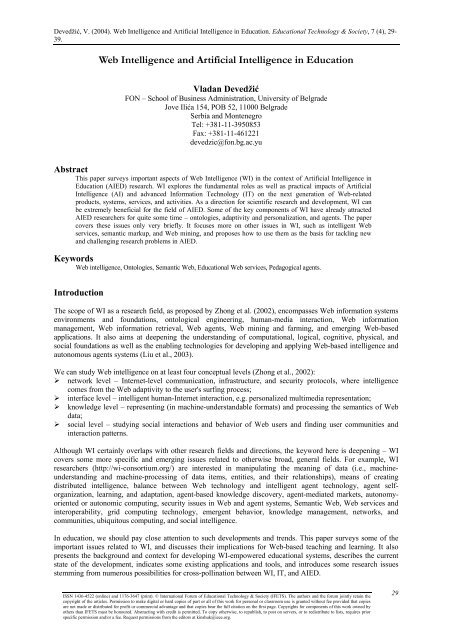Ontologies and the Semantic Web for E-learning - Educational ...
Ontologies and the Semantic Web for E-learning - Educational ...
Ontologies and the Semantic Web for E-learning - Educational ...
You also want an ePaper? Increase the reach of your titles
YUMPU automatically turns print PDFs into web optimized ePapers that Google loves.
Devedžić, V. (2004). <strong>Web</strong> Intelligence <strong>and</strong> Artificial Intelligence in Education. <strong>Educational</strong> Technology & Society, 7 (4), 29-<br />
39.<br />
<strong>Web</strong> Intelligence <strong>and</strong> Artificial Intelligence in Education<br />
Vladan Devedžić<br />
FON – School of Business Administration, University of Belgrade<br />
Jove Ilića 154, POB 52, 11000 Belgrade<br />
Serbia <strong>and</strong> Montenegro<br />
Tel: +381-11-3950853<br />
Fax: +381-11-461221<br />
devedzic@fon.bg.ac.yu<br />
Abstract<br />
This paper surveys important aspects of <strong>Web</strong> Intelligence (WI) in <strong>the</strong> context of Artificial Intelligence in<br />
Education (AIED) research. WI explores <strong>the</strong> fundamental roles as well as practical impacts of Artificial<br />
Intelligence (AI) <strong>and</strong> advanced In<strong>for</strong>mation Technology (IT) on <strong>the</strong> next generation of <strong>Web</strong>-related<br />
products, systems, services, <strong>and</strong> activities. As a direction <strong>for</strong> scientific research <strong>and</strong> development, WI can<br />
be extremely beneficial <strong>for</strong> <strong>the</strong> field of AIED. Some of <strong>the</strong> key components of WI have already attracted<br />
AIED researchers <strong>for</strong> quite some time – ontologies, adaptivity <strong>and</strong> personalization, <strong>and</strong> agents. The paper<br />
covers <strong>the</strong>se issues only very briefly. It focuses more on o<strong>the</strong>r issues in WI, such as intelligent <strong>Web</strong><br />
services, semantic markup, <strong>and</strong> <strong>Web</strong> mining, <strong>and</strong> proposes how to use <strong>the</strong>m as <strong>the</strong> basis <strong>for</strong> tackling new<br />
<strong>and</strong> challenging research problems in AIED.<br />
Keywords<br />
<strong>Web</strong> intelligence, <strong>Ontologies</strong>, <strong>Semantic</strong> <strong>Web</strong>, <strong>Educational</strong> <strong>Web</strong> services, Pedagogical agents.<br />
Introduction<br />
The scope of WI as a research field, as proposed by Zhong et al. (2002), encompasses <strong>Web</strong> in<strong>for</strong>mation systems<br />
environments <strong>and</strong> foundations, ontological engineering, human-media interaction, <strong>Web</strong> in<strong>for</strong>mation<br />
management, <strong>Web</strong> in<strong>for</strong>mation retrieval, <strong>Web</strong> agents, <strong>Web</strong> mining <strong>and</strong> farming, <strong>and</strong> emerging <strong>Web</strong>-based<br />
applications. It also aims at deepening <strong>the</strong> underst<strong>and</strong>ing of computational, logical, cognitive, physical, <strong>and</strong><br />
social foundations as well as <strong>the</strong> enabling technologies <strong>for</strong> developing <strong>and</strong> applying <strong>Web</strong>-based intelligence <strong>and</strong><br />
autonomous agents systems (Liu et al., 2003).<br />
We can study <strong>Web</strong> intelligence on at least four conceptual levels (Zhong et al., 2002):<br />
network level – Internet-level communication, infrastructure, <strong>and</strong> security protocols, where intelligence<br />
comes from <strong>the</strong> <strong>Web</strong> adaptivity to <strong>the</strong> user's surfing process;<br />
interface level – intelligent human-Internet interaction, e.g. personalized multimedia representation;<br />
knowledge level – representing (in machine-underst<strong>and</strong>able <strong>for</strong>mats) <strong>and</strong> processing <strong>the</strong> semantics of <strong>Web</strong><br />
data;<br />
social level – studying social interactions <strong>and</strong> behavior of <strong>Web</strong> users <strong>and</strong> finding user communities <strong>and</strong><br />
interaction patterns.<br />
Although WI certainly overlaps with o<strong>the</strong>r research fields <strong>and</strong> directions, <strong>the</strong> keyword here is deepening – WI<br />
covers some more specific <strong>and</strong> emerging issues related to o<strong>the</strong>rwise broad, general fields. For example, WI<br />
researchers (http://wi-consortium.org/) are interested in manipulating <strong>the</strong> meaning of data (i.e., machineunderst<strong>and</strong>ing<br />
<strong>and</strong> machine-processing of data items, entities, <strong>and</strong> <strong>the</strong>ir relationships), means of creating<br />
distributed intelligence, balance between <strong>Web</strong> technology <strong>and</strong> intelligent agent technology, agent sel<strong>for</strong>ganization,<br />
<strong>learning</strong>, <strong>and</strong> adaptation, agent-based knowledge discovery, agent-mediated markets, autonomyoriented<br />
or autonomic computing, security issues in <strong>Web</strong> <strong>and</strong> agent systems, <strong>Semantic</strong> <strong>Web</strong>, <strong>Web</strong> services <strong>and</strong><br />
interoperability, grid computing technology, emergent behavior, knowledge management, networks, <strong>and</strong><br />
communities, ubiquitous computing, <strong>and</strong> social intelligence.<br />
In education, we should pay close attention to such developments <strong>and</strong> trends. This paper surveys some of <strong>the</strong><br />
important issues related to WI, <strong>and</strong> discusses <strong>the</strong>ir implications <strong>for</strong> <strong>Web</strong>-based teaching <strong>and</strong> <strong>learning</strong>. It also<br />
presents <strong>the</strong> background <strong>and</strong> context <strong>for</strong> developing WI-empowered educational systems, describes <strong>the</strong> current<br />
state of <strong>the</strong> development, indicates some existing applications <strong>and</strong> tools, <strong>and</strong> introduces some research issues<br />
stemming from numerous possibilities <strong>for</strong> cross-pollination between WI, IT, <strong>and</strong> AIED.<br />
ISSN 1436-4522 (online) <strong>and</strong> 1176-3647 (print). © International Forum of <strong>Educational</strong> Technology & Society (IFETS). The authors <strong>and</strong> <strong>the</strong> <strong>for</strong>um jointly retain <strong>the</strong><br />
copyright of <strong>the</strong> articles. Permission to make digital or hard copies of part or all of this work <strong>for</strong> personal or classroom use is granted without fee provided that copies<br />
are not made or distributed <strong>for</strong> profit or commercial advantage <strong>and</strong> that copies bear <strong>the</strong> full citation on <strong>the</strong> first page. Copyrights <strong>for</strong> components of this work owned by<br />
o<strong>the</strong>rs than IFETS must be honoured. Abstracting with credit is permitted. To copy o<strong>the</strong>rwise, to republish, to post on servers, or to redistribute to lists, requires prior<br />
specific permission <strong>and</strong>/or a fee. Request permissions from <strong>the</strong> editors at kinshuk@ieee.org.<br />
29
















